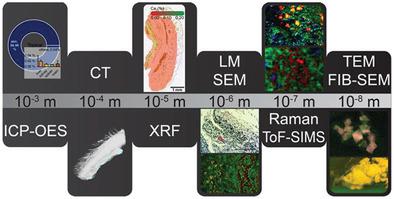Our official English website, www.x-mol.net, welcomes your feedback! (Note: you will need to create a separate account there.)
Multiscale Analysis of Metal Oxide Nanoparticles in Tissue: Insights into Biodistribution and Biotransformation.
Advanced Science ( IF 15.1 ) Pub Date : 2020-06-18 , DOI: 10.1002/advs.202000912 Martin T Matter 1, 2 , Jian-Hao Li 1, 2 , Ioana Lese 3 , Claudia Schreiner 4 , Laetitia Bernard 5 , Olivier Scholder 5 , Jasmin Hubeli 4 , Kerda Keevend 1, 2 , Elena Tsolaki 1, 2, 6 , Enrico Bertero 7 , Sergio Bertazzo 6 , Robert Zboray 8 , Radu Olariu 3 , Mihai A Constantinescu 3 , Renato Figi 4 , Inge K Herrmann 1, 2
Advanced Science ( IF 15.1 ) Pub Date : 2020-06-18 , DOI: 10.1002/advs.202000912 Martin T Matter 1, 2 , Jian-Hao Li 1, 2 , Ioana Lese 3 , Claudia Schreiner 4 , Laetitia Bernard 5 , Olivier Scholder 5 , Jasmin Hubeli 4 , Kerda Keevend 1, 2 , Elena Tsolaki 1, 2, 6 , Enrico Bertero 7 , Sergio Bertazzo 6 , Robert Zboray 8 , Radu Olariu 3 , Mihai A Constantinescu 3 , Renato Figi 4 , Inge K Herrmann 1, 2
Affiliation

|
Metal oxide nanoparticles have emerged as exceptionally potent biomedical sensors and actuators due to their unique physicochemical features. Despite fascinating achievements, the current limited understanding of the molecular interplay between nanoparticles and the surrounding tissue remains a major obstacle in the rationalized development of nanomedicines, which is reflected in their poor clinical approval rate. This work reports on the nanoscopic characterization of inorganic nanoparticles in tissue by the example of complex metal oxide nanoparticle hybrids consisting of crystalline cerium oxide and the biodegradable ceramic bioglass. A validated analytical method based on semiquantitative X‐ray fluorescence and inductively coupled plasma spectrometry is used to assess nanoparticle biodistribution following intravenous and topical application. Then, a correlative multiscale analytical cascade based on a combination of microscopy and spectroscopy techniques shows that the topically applied hybrid nanoparticles remain at the initial site and are preferentially taken up into macrophages, form apatite on their surface, and lead to increased accumulation of lipids in their surroundings. Taken together, this work displays how modern analytical techniques can be harnessed to gain unprecedented insights into the biodistribution and biotransformation of complex inorganic nanoparticles. Such nanoscopic characterization is imperative for the rationalized engineering of safe and efficacious nanoparticle‐based systems.
中文翻译:

组织中金属氧化物纳米颗粒的多尺度分析:对生物分布和生物转化的见解。
金属氧化物纳米颗粒由于其独特的物理化学特征而已成为非常有效的生物医学传感器和致动器。尽管取得了令人着迷的成就,但当前对纳米粒子与周围组织之间的分子相互作用的有限了解仍然是纳米药物合理化发展的主要障碍,这反映在它们的临床批准率低下。这项工作报告了组织中无机纳米颗粒的纳米特征,该复合物的实例是由结晶氧化铈和可生物降解的陶瓷生物玻璃组成的复杂金属氧化物纳米颗粒杂化物。经过验证的基于半定量X射线荧光和电感耦合等离子体光谱法的分析方法用于评估静脉和局部应用后纳米颗粒的生物分布。然后,基于显微镜和光谱技术相结合的相关多尺度分析级联显示,局部应用的杂化纳米颗粒保留在初始位置,并优先被巨噬细胞吸收,在其表面形成磷灰石,并导致脂质堆积增加。他们的周围。总而言之,这项工作展示了如何利用现代分析技术获得对复杂无机纳米粒子的生物分布和生物转化的前所未有的见解。对于安全有效的基于纳米颗粒的系统的合理工程设计,这种纳米表征是必不可少的。基于显微镜和光谱技术相结合的相关多尺度分析级联显示,局部应用的杂化纳米颗粒保留在初始位置,并优先被巨噬细胞吸收,在其表面形成磷灰石,并导致脂质在周围环境中积累的增加。总而言之,这项工作展示了如何利用现代分析技术获得对复杂无机纳米粒子的生物分布和生物转化的前所未有的见解。对于安全有效的基于纳米颗粒的系统的合理工程设计,这种纳米表征是必不可少的。基于显微镜和光谱技术相结合的相关多尺度分析级联显示,局部应用的杂化纳米颗粒保留在初始位置,并优先被巨噬细胞吸收,在其表面形成磷灰石,并导致脂质在周围环境中积累的增加。总而言之,这项工作展示了如何利用现代分析技术获得对复杂无机纳米粒子的生物分布和生物转化的前所未有的见解。对于安全有效的基于纳米颗粒的系统的合理工程设计,这种纳米表征是必不可少的。这项工作展示了如何利用现代分析技术来获得对复杂无机纳米粒子的生物分布和生物转化的前所未有的见识。对于安全有效的基于纳米颗粒的系统的合理工程设计,这种纳米表征是必不可少的。这项工作展示了如何利用现代分析技术来获得对复杂无机纳米粒子的生物分布和生物转化的前所未有的见识。对于安全有效的基于纳米粒子的系统的合理工程设计,这种纳米特性是必不可少的。
更新日期:2020-08-05
中文翻译:

组织中金属氧化物纳米颗粒的多尺度分析:对生物分布和生物转化的见解。
金属氧化物纳米颗粒由于其独特的物理化学特征而已成为非常有效的生物医学传感器和致动器。尽管取得了令人着迷的成就,但当前对纳米粒子与周围组织之间的分子相互作用的有限了解仍然是纳米药物合理化发展的主要障碍,这反映在它们的临床批准率低下。这项工作报告了组织中无机纳米颗粒的纳米特征,该复合物的实例是由结晶氧化铈和可生物降解的陶瓷生物玻璃组成的复杂金属氧化物纳米颗粒杂化物。经过验证的基于半定量X射线荧光和电感耦合等离子体光谱法的分析方法用于评估静脉和局部应用后纳米颗粒的生物分布。然后,基于显微镜和光谱技术相结合的相关多尺度分析级联显示,局部应用的杂化纳米颗粒保留在初始位置,并优先被巨噬细胞吸收,在其表面形成磷灰石,并导致脂质堆积增加。他们的周围。总而言之,这项工作展示了如何利用现代分析技术获得对复杂无机纳米粒子的生物分布和生物转化的前所未有的见解。对于安全有效的基于纳米颗粒的系统的合理工程设计,这种纳米表征是必不可少的。基于显微镜和光谱技术相结合的相关多尺度分析级联显示,局部应用的杂化纳米颗粒保留在初始位置,并优先被巨噬细胞吸收,在其表面形成磷灰石,并导致脂质在周围环境中积累的增加。总而言之,这项工作展示了如何利用现代分析技术获得对复杂无机纳米粒子的生物分布和生物转化的前所未有的见解。对于安全有效的基于纳米颗粒的系统的合理工程设计,这种纳米表征是必不可少的。基于显微镜和光谱技术相结合的相关多尺度分析级联显示,局部应用的杂化纳米颗粒保留在初始位置,并优先被巨噬细胞吸收,在其表面形成磷灰石,并导致脂质在周围环境中积累的增加。总而言之,这项工作展示了如何利用现代分析技术获得对复杂无机纳米粒子的生物分布和生物转化的前所未有的见解。对于安全有效的基于纳米颗粒的系统的合理工程设计,这种纳米表征是必不可少的。这项工作展示了如何利用现代分析技术来获得对复杂无机纳米粒子的生物分布和生物转化的前所未有的见识。对于安全有效的基于纳米颗粒的系统的合理工程设计,这种纳米表征是必不可少的。这项工作展示了如何利用现代分析技术来获得对复杂无机纳米粒子的生物分布和生物转化的前所未有的见识。对于安全有效的基于纳米粒子的系统的合理工程设计,这种纳米特性是必不可少的。


























 京公网安备 11010802027423号
京公网安备 11010802027423号